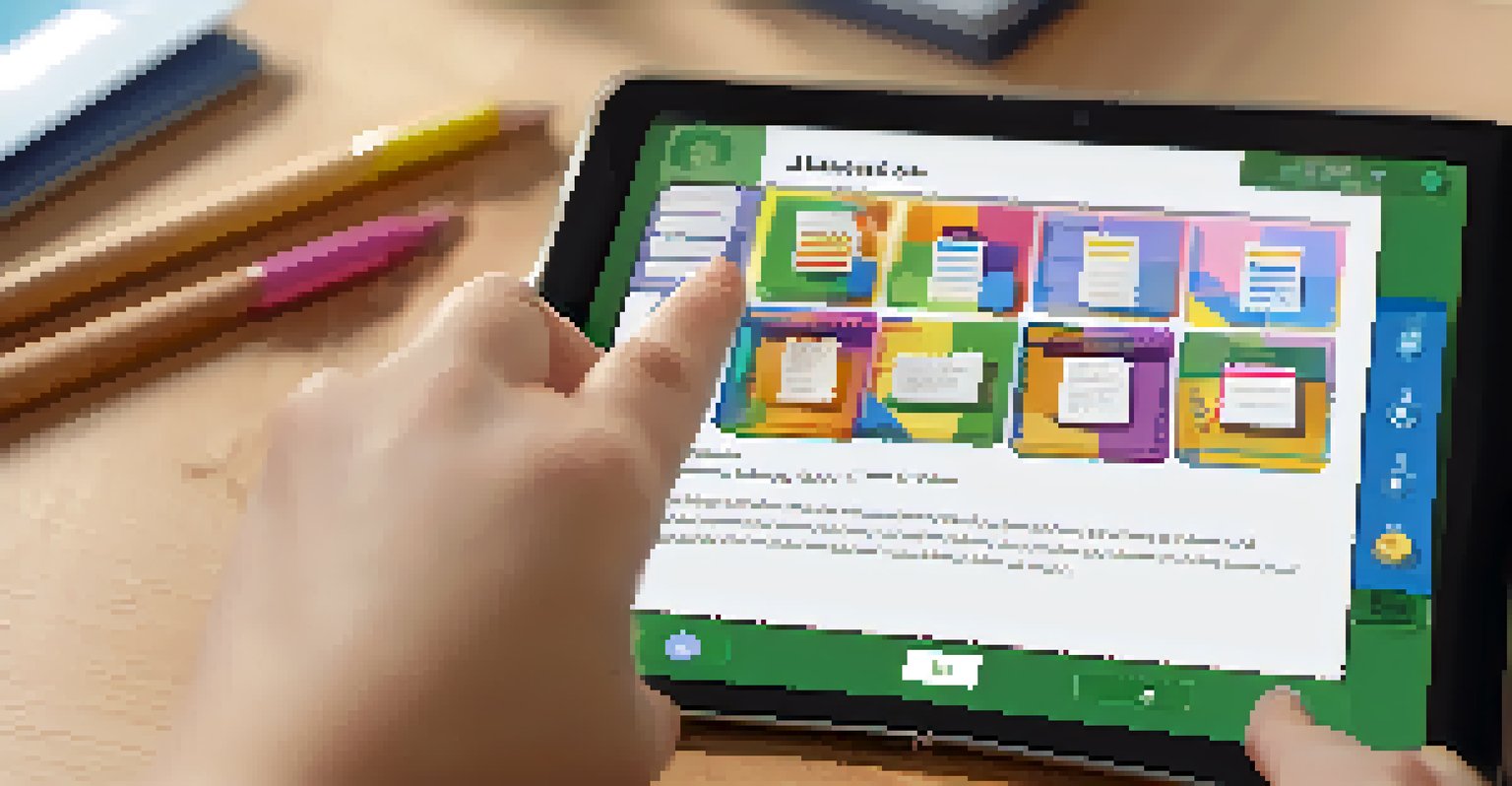Using Interactive Assessments to Boost Student Engagement

Understanding Interactive Assessments and Their Benefits
Interactive assessments are dynamic tools that actively involve students in the learning process. Unlike traditional tests, they encourage participation through quizzes, games, and simulations. This engagement can lead to better retention of information and a deeper understanding of the material.
The greatest sign of success for a teacher is to be able to say, 'The children are now working as if I did not exist.'
The primary benefit of these assessments is their ability to cater to various learning styles. For instance, visual learners can thrive with interactive graphics, while kinesthetic learners may prefer hands-on activities. By accommodating different preferences, interactive assessments can enhance overall classroom engagement.
Moreover, these assessments provide immediate feedback, allowing students to identify areas for improvement in real time. This instant response creates a more personalized learning experience, where students can adjust their strategies and approaches based on their performance.
Creating Engaging Interactive Assessments
Designing effective interactive assessments involves creativity and an understanding of your students' needs. Start by defining clear learning objectives that align with your curriculum. Then, brainstorm assessment formats that encourage interaction, such as group projects or digital quizzes.

Incorporating technology can significantly enhance the interactive experience. Platforms like Kahoot! or Quizizz allow for real-time participation and can make assessments feel more like games than tests. This gamification can turn a potentially stressful experience into a fun and engaging one.
Engagement through Interactivity
Interactive assessments actively involve students, enhancing engagement and improving retention of information.
Don’t forget to include elements that encourage collaboration among students. Group assessments not only boost engagement but also foster teamwork skills, preparing students for real-world scenarios. This collaborative approach can create a more vibrant classroom environment.
Utilizing Technology to Enhance Assessments
Technology plays a crucial role in implementing interactive assessments effectively. With tools like Google Forms or Microsoft Teams, educators can create assessments that are easy to access and complete. This convenience can increase participation rates as students can engage from anywhere.
The ability to learn faster than your competitors may be the only sustainable competitive advantage.
Additionally, incorporating multimedia elements such as videos or infographics can make assessments more appealing. For example, a video quiz can provide context and make the learning material more relatable. This multimedia approach helps maintain students' interest and attention.
Furthermore, technology can facilitate data collection and analysis, helping educators track student progress over time. By analyzing results, teachers can identify trends and adapt their teaching methods to better meet students’ needs, ensuring no one falls behind.
The Role of Feedback in Interactive Assessments
Feedback is a vital component of interactive assessments, as it guides students in their learning journey. Providing constructive feedback helps students understand their strengths and areas needing improvement. This guidance can motivate them to strive for mastery rather than just passing a test.
In addition to personal feedback, peer reviews can also be beneficial. Allowing students to review each other’s work fosters a sense of community and encourages collaboration. It also helps students learn to critique constructively, which is a valuable skill in both academic and professional settings.
Technology Enhances Assessments
Utilizing technology like quizzes and multimedia elements makes assessments more accessible and appealing to students.
Moreover, timely feedback can enhance the overall learning experience. When students receive insights right after completing an assessment, they are more likely to retain the information. This immediate reinforcement can lead to improved performance in future assessments.
Challenges of Implementing Interactive Assessments
While interactive assessments offer numerous benefits, they do come with challenges. One major hurdle is the technology gap; not all students may have access to the necessary devices or internet connectivity. This disparity can lead to unequal participation and engagement levels.
Another challenge is the time required to create and implement these assessments effectively. Designing interactive assessments can be more time-consuming than traditional methods. Educators must balance the workload while ensuring they provide engaging and meaningful assessments.
Lastly, teachers need to be trained in using new tools and technologies. Professional development opportunities are essential for educators to feel comfortable integrating interactive assessments into their teaching practices. Without proper training, the potential of these tools may not be fully realized.
Measuring the Effectiveness of Interactive Assessments
To ensure that interactive assessments are effective, it's essential to measure their impact on student engagement and learning outcomes. Educators can use analytics from assessment platforms to track participation rates and performance metrics. These insights can help determine whether the assessments achieve their intended goals.
Surveys and feedback from students can also provide valuable information regarding their experiences with interactive assessments. Asking students about their engagement levels and learning preferences can help educators refine their approaches. This feedback loop is crucial for continuous improvement.
Feedback Drives Learning Success
Timely and constructive feedback from interactive assessments helps students understand their strengths and areas for improvement.
Additionally, comparing traditional assessment results with those from interactive formats can highlight their effectiveness. If students show improved understanding and retention through interactive methods, it reinforces the value of adopting these innovative approaches in the classroom.
Future Trends in Interactive Assessments
As technology continues to evolve, so will the landscape of interactive assessments. We can expect to see more immersive experiences, such as virtual and augmented reality assessments, which can transport students into different environments and scenarios. This level of engagement can revolutionize how students learn and interact with the material.
Artificial intelligence may also play a role in personalizing assessments further. AI-driven platforms can adapt questions based on a student’s performance, providing tailored challenges that match their skill level. This customization can enhance the learning experience by ensuring that each student is engaged appropriately.

Ultimately, the future of interactive assessments lies in their ability to foster deeper connections between students and the learning material. By embracing innovation and prioritizing engagement, educators can create a more dynamic and effective learning environment for all students.